Six Flags Great America – Gurnee, Illinois
Bolliger & Mabillard do not design intense roller coasters anymore. Sure, some of their rides might have moments of forcefulness, but none from the past decade would make a seasoned coaster enthusiast question putting their hands up for the entire ride. This is not a necessarily value judgment on B&M coasters, just an observation of fact. Rather than intensity, it seems that for most of their career B&M have wanted to specialize in “flight sensations”.
The very first unique vehicle design they made as an independent company wasn’t the standard sit-down as one might have expected, but the radically innovative inverted coaster. Although increasing the rider’s exposure below the seats proved a huge success for roller coaster design, you couldn’t see the sky and the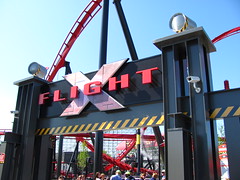 back rows would feel shut in, so they needed a new formula for simulating flight. 1999 saw the debut of the floorless coaster, which solved some of the visibility problems of the inverted configuration, but returning the track below the riders eliminated the sensation of being dangled above a landscape in open air, and the resulting perception was negligibly different from a sit-down design with raised seats. The introduction of the flying coaster in 2002 represented a more obvious attempt at capturing the feeling of free flight, and although the Superman positioning the rider and the unobstructed view got the “flight” part right, the hefty restraints and awkward gravitational pull on the body meant that the “free” part had taken a step backward. I think their greatest success in achieving a flight sensation was ironically found in a design
back rows would feel shut in, so they needed a new formula for simulating flight. 1999 saw the debut of the floorless coaster, which solved some of the visibility problems of the inverted configuration, but returning the track below the riders eliminated the sensation of being dangled above a landscape in open air, and the resulting perception was negligibly different from a sit-down design with raised seats. The introduction of the flying coaster in 2002 represented a more obvious attempt at capturing the feeling of free flight, and although the Superman positioning the rider and the unobstructed view got the “flight” part right, the hefty restraints and awkward gravitational pull on the body meant that the “free” part had taken a step backward. I think their greatest success in achieving a flight sensation was ironically found in a design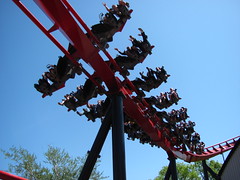 originally intended to simulate falling like a brick, when they gave their Dive Machines ten abreast floorless seating in 2007. Sitting on an outside row of the massive vehicle allowed for a clear view both above and below the rider as on the flying coaster, but the upright seating felt more natural and unobtrusive, the rider free to look where they pleased rather than be forced to gaze straight down with gravity.
originally intended to simulate falling like a brick, when they gave their Dive Machines ten abreast floorless seating in 2007. Sitting on an outside row of the massive vehicle allowed for a clear view both above and below the rider as on the flying coaster, but the upright seating felt more natural and unobtrusive, the rider free to look where they pleased rather than be forced to gaze straight down with gravity.
Twenty years after the inverted coaster was first introduced, B&M have returned to Six Flags Great America with a new roller coaster design that might finally achieve what they’ve always been striving for. By placing riders to the side of the track, the wing coaster combines the best aspects of the inverted and floorless designs, and places riders in a much more open, minimalistic seat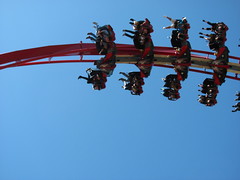 configuration than allowed by their flying coasters. Relative to its rather small scale, the new for 2012 X-Flight achieves a flying sensation better than any other coaster I’ve been on. It was also the first time in a long time I felt like I experienced something completely new and different on a B&M coaster. X-Flight is simultaneously graceful and unpredictable, and is the best roller coaster built at Six Flags Great America since either Raging Bull or Batman: The Ride, depending on if I count the former with or without trim brakes. I’m not exactly sure what the “X” is meant to signify, but whatever it is, it makes flight better than even Superman’s ultimate.
configuration than allowed by their flying coasters. Relative to its rather small scale, the new for 2012 X-Flight achieves a flying sensation better than any other coaster I’ve been on. It was also the first time in a long time I felt like I experienced something completely new and different on a B&M coaster. X-Flight is simultaneously graceful and unpredictable, and is the best roller coaster built at Six Flags Great America since either Raging Bull or Batman: The Ride, depending on if I count the former with or without trim brakes. I’m not exactly sure what the “X” is meant to signify, but whatever it is, it makes flight better than even Superman’s ultimate.
Now that I’ve taken care of the initial praise (if you’re looking for a simple “yay” or “nay” recommendation, the answer is “yay”),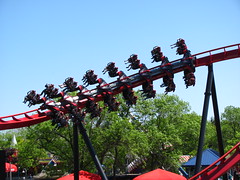 it’s time to get on with my favorite part of any ride analysis: the criticism. Although the wing coaster does “flight sensation” better than other configurations, it’s also the most limited in force and dynamic contrasts. There are various reasons for this, possibly owing to stress on the cantilevered wings (although the physiology of the rider is still probably the main limiting factor on forces, rather than the frailty of the steel arms), and a need to reduce vibrations that become amplified as they move further away from the track (I noticed some ‘flapping’ in the back rows, nothing too major but it could potentially lead to a headache depending on your constitution). However, the main reason the pacing and intensity must be slowed down on wing coasters is because the rider’s path lacks a single centerline. When the track begins to bank
it’s time to get on with my favorite part of any ride analysis: the criticism. Although the wing coaster does “flight sensation” better than other configurations, it’s also the most limited in force and dynamic contrasts. There are various reasons for this, possibly owing to stress on the cantilevered wings (although the physiology of the rider is still probably the main limiting factor on forces, rather than the frailty of the steel arms), and a need to reduce vibrations that become amplified as they move further away from the track (I noticed some ‘flapping’ in the back rows, nothing too major but it could potentially lead to a headache depending on your constitution). However, the main reason the pacing and intensity must be slowed down on wing coasters is because the rider’s path lacks a single centerline. When the track begins to bank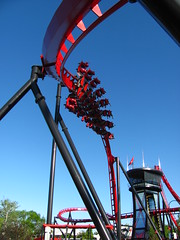 around a curve, riders on one side of the train will rise while those on the other will fall. Without a heartline that the track can be built around, there’s virtually no possibility for any tight rotational transitions on a wing coaster without encountering some really bizarre and possibly dangerous forces. All of the 4D coasters from S&S/Arrow or Intamin try to avoid inline transitioning as much as possible in favor of other ways to turn the track around, and while Furius Baco has a few fast corners, at 80mph the length of the transitions is still quite large compared to the wingspan of the trains (and I wouldn’t call that coaster a resounding success at rider comfort anyway).
around a curve, riders on one side of the train will rise while those on the other will fall. Without a heartline that the track can be built around, there’s virtually no possibility for any tight rotational transitions on a wing coaster without encountering some really bizarre and possibly dangerous forces. All of the 4D coasters from S&S/Arrow or Intamin try to avoid inline transitioning as much as possible in favor of other ways to turn the track around, and while Furius Baco has a few fast corners, at 80mph the length of the transitions is still quite large compared to the wingspan of the trains (and I wouldn’t call that coaster a resounding success at rider comfort anyway).
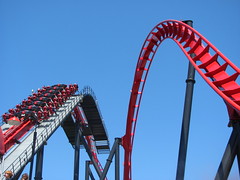 With that said, it should be very interesting to note that X-Flight’s layout seems to make more use of inline transitions than most other coaster configurations B&M have designed to date. There’s the twist at the top of the lift,
With that said, it should be very interesting to note that X-Flight’s layout seems to make more use of inline transitions than most other coaster configurations B&M have designed to date. There’s the twist at the top of the lift,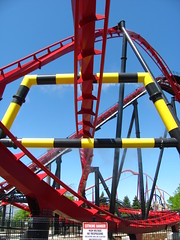 the first zero-G roll, the twist out of the Immelmann, the second zero-G roll/corkscrew, and then of course the signature inline barrel roll through the control tower, as well as a few other banking transitions sprinkled around the
the first zero-G roll, the twist out of the Immelmann, the second zero-G roll/corkscrew, and then of course the signature inline barrel roll through the control tower, as well as a few other banking transitions sprinkled around the layout. None of these rotations are taken very fast, but they’re still tight enough relative to the wingspan that you encounter some really funky dynamics. I’ve always wanted B&M’s designs to feel a little less controlled, and although I usually think about this in terms of force and pacing, losing control over the heartline also works
layout. None of these rotations are taken very fast, but they’re still tight enough relative to the wingspan that you encounter some really funky dynamics. I’ve always wanted B&M’s designs to feel a little less controlled, and although I usually think about this in terms of force and pacing, losing control over the heartline also works at returning some character to the experience.
at returning some character to the experience.
Back to the criticism: although the ride looked stunning on opening weekend with its blood red and graphite grey color scheme and bevy of modernistic props and architecture, I’m worried this look won’t age well and in a few years after it has lost its new coaster shine it will become another faded, thematically-incorrect steel monument on an empty square lot surrounded by the shells of disused special effects, and the high visibility of the structure on the midway will become a curse rather than a blessing. Six Flags doesn’t necessarily have the best track record in regards to this sort of upkeep (2008’s Dark Knight coaster has recently become divorced of its preshow, queue themeing, and music/sound effects, and the resulting attraction is now more depressing than it is lame), but for now I’ll retain my optimism that Six Flags will prove me wrong about X-Flight and enjoy the eye candy while it lasts.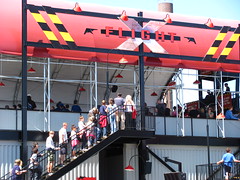
Also, as cool as X-Flight looks now, it looked a lot cooler when I rode it in California where it was called X2. Although for a coaster enthusiast the comparison between these two attractions might not be immediately obvious, from the perspective of the marketing department they’re virtually indistinguishable. Same color scheme, same clamshell steel station, same ambiguous “xtreme” theme, and even the logo has the exact same steel boilerplate design. The only difference is that X2 is much more theatrical and grandiose, and X-Flight has narrowed the theme down to something to do with stealth fighter jets, although I’m missing the ability to play with fun postmodern interpretations of the theme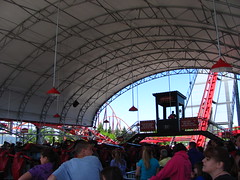 that X2’s vague pop culture references allowed.
that X2’s vague pop culture references allowed.
The station in particular needs some work. Aesthetically it leaves something to be desired, but I’ll ignore that for now and focus on logistics. If riders can’t exit on the opposite side of the train it needs either a separate unloading platform or something like the cattle pen boarding setup found on Eejanaika. Efficiency becomes an issue when they have to wait for everyone to gather their belongings and exit the far end of the platform before they can open the airgates for the next set of riders. Dispatch times on the whole could use a bit more work, but I guess that’s to be expected during the opening week of a new attraction. The winged design also presents a social problem: who gets the outside row?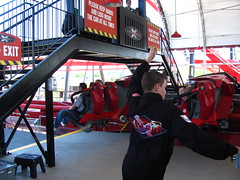 Since the winged seating is the primary gimmick separating X-Flight from other coasters at the park, the outside row has significantly more value for most riders than the inside row, and if lines are long and your riding partner and you are expecting this to be your first and only ride of the day, there’s going to be a discussion that ends with someone making a sacrifice. With me, it usually tends to be the other guy. (Sorry, Dan.)
Since the winged seating is the primary gimmick separating X-Flight from other coasters at the park, the outside row has significantly more value for most riders than the inside row, and if lines are long and your riding partner and you are expecting this to be your first and only ride of the day, there’s going to be a discussion that ends with someone making a sacrifice. With me, it usually tends to be the other guy. (Sorry, Dan.)
The seats are comfortable and the restraints are well designed. I wasn’t sure what I’d think of them because I can’t say I’m a big fan of the flexible vest/shoulder strap arrangement found on some of the newer Vekoma and Intamin coasters. While they eliminate the risk of any hard material playing ping-pong with your skull, they also tend to be a much snugger fit over the shoulders and keep anyone of even a moderate body build pressed firmly against the seat back; riders over six foot tall have reported even more discomfort with these than with the standard hard restraints. Thankfully, B&M resolved this issue by attaching the top of the vest to a retractable belt, which allows you to lean forward off the seat back without too much resistance (this is important should the ride ever pick up a rattle, plus it makes hanging over the diving first drop more fun), and it makes the restraints much more accommodating
and keep anyone of even a moderate body build pressed firmly against the seat back; riders over six foot tall have reported even more discomfort with these than with the standard hard restraints. Thankfully, B&M resolved this issue by attaching the top of the vest to a retractable belt, which allows you to lean forward off the seat back without too much resistance (this is important should the ride ever pick up a rattle, plus it makes hanging over the diving first drop more fun), and it makes the restraints much more accommodating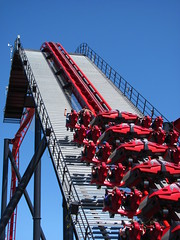 to riders of different body types.
to riders of different body types.
Now that we’ve made it into our seats, what about the ride experience that awaits?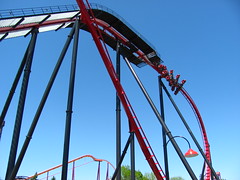 The chain lift incline is steeper than usual which means we reach the top in very short time, and coupled with the wide breadth of the catwalk makes the coaster appear shorter than 120’. But perhaps this illusion is for the best, if only because it makes cresting the lift and being greeted with the slow rollover into the initial dive loop feel much more shocking by comparison. I mentioned earlier that
The chain lift incline is steeper than usual which means we reach the top in very short time, and coupled with the wide breadth of the catwalk makes the coaster appear shorter than 120’. But perhaps this illusion is for the best, if only because it makes cresting the lift and being greeted with the slow rollover into the initial dive loop feel much more shocking by comparison. I mentioned earlier that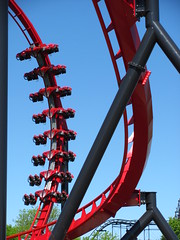 in many ways this coaster feels like a departure from the formulaic B&M design, and although I meant that mostly in regards to the unusual dynamics of a non-heartlined roller coaster, it also applies to the individual elements. This dive loop in particular is a refreshingly different way to gain kinetic energy, as I’ve become numb to the effects of the various curving and straight drops that have been implemented in various forms on roller coasters ever since the days of L.A. Thompson, with even beyond vertical drops becoming staid after more than a few times. I’m sure the dive loop first drop will eventually become tired as well if it’s repeated too often, but at this moment in history it’s something I’ve not encountered before, and I’m appreciative of that. Front row, left side is the best seat for experiencing this maneuver, mixing awkward hangtime and laterals with an uneasy feeling of vertigo as you rotate around the track and can look straight up, and then forward, at the ground below.
in many ways this coaster feels like a departure from the formulaic B&M design, and although I meant that mostly in regards to the unusual dynamics of a non-heartlined roller coaster, it also applies to the individual elements. This dive loop in particular is a refreshingly different way to gain kinetic energy, as I’ve become numb to the effects of the various curving and straight drops that have been implemented in various forms on roller coasters ever since the days of L.A. Thompson, with even beyond vertical drops becoming staid after more than a few times. I’m sure the dive loop first drop will eventually become tired as well if it’s repeated too often, but at this moment in history it’s something I’ve not encountered before, and I’m appreciative of that. Front row, left side is the best seat for experiencing this maneuver, mixing awkward hangtime and laterals with an uneasy feeling of vertigo as you rotate around the track and can look straight up, and then forward, at the ground below.
Most early reviews seem to cite the first and last inversions as X-Flight’s highlights, but I’d argue that the second inversion, a zero-G camelback roll, deserves special recognition as well. Sitting on the wing in the left side of the train, the seat is pulled out from under you and you do this strange weightless tango around the track that you can’t really predict beforehand. On standard coasters the heartline rolls might appear as crazy sections of track the way it curls around an invisible center path, but then the actual experience can feel very controlled. But on a wing coaster the opposite is the case, and the combination of looking mundane but then riding a bit off-kilter is far more effective psychologically. The track’s pathway is no longer necessarily your pathway, and the inability to visualize exactly how your body will be contorted next even as you trace the rail outline with your eyes is what allows X-Flight to be simultaneously unpredictable and graceful.
camelback roll, deserves special recognition as well. Sitting on the wing in the left side of the train, the seat is pulled out from under you and you do this strange weightless tango around the track that you can’t really predict beforehand. On standard coasters the heartline rolls might appear as crazy sections of track the way it curls around an invisible center path, but then the actual experience can feel very controlled. But on a wing coaster the opposite is the case, and the combination of looking mundane but then riding a bit off-kilter is far more effective psychologically. The track’s pathway is no longer necessarily your pathway, and the inability to visualize exactly how your body will be contorted next even as you trace the rail outline with your eyes is what allows X-Flight to be simultaneously unpredictable and graceful.
The next several maneuvers repeat this formula but without the same degree of remarkability of the first elements. The Immelmann inversion is basically an inverse of the first dive loop but absent the unique approach which means it gets lost amid the layout; the red-headed, unloved middle inversion, as it were. A water splashdown effect on the following ground-hugging turn is a neat change of pace, and although it doesn’t look
turn is a neat change of pace, and although it doesn’t look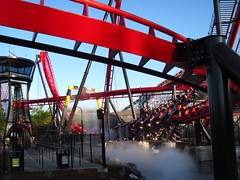 as natural or convincing as on Manta or Shambhala and serves mostly to get the right side of the train a little wet, it’s certainly better than nothing and I appreciate that they’re attempting to make every moment unique. The next inversion is similar to the first zero-G barrel roll I praised, but this one is more corkscrew-shaped than inline, and therefore the unpredictable
as natural or convincing as on Manta or Shambhala and serves mostly to get the right side of the train a little wet, it’s certainly better than nothing and I appreciate that they’re attempting to make every moment unique. The next inversion is similar to the first zero-G barrel roll I praised, but this one is more corkscrew-shaped than inline, and therefore the unpredictable dynamics are somewhat neutered. The low point of the ride is when we dip through a lame cut-out “jet hangar” on the exit of this inversion. This either needs to be made three-dimensional or should be scrapped altogether, because without any tunnel effect it’s completely forgettable on-ride, and off-ride it just looks cheap and makeshift, especially as it stands in a very visible location from both the queue and the main midway, and is immediately comparable to the much more attractive control tower nearby. The following inclined helix, although banked at nearly 90°, is the tamest part of the ride, and also the first time the winged seating isn’t put to good use.
dynamics are somewhat neutered. The low point of the ride is when we dip through a lame cut-out “jet hangar” on the exit of this inversion. This either needs to be made three-dimensional or should be scrapped altogether, because without any tunnel effect it’s completely forgettable on-ride, and off-ride it just looks cheap and makeshift, especially as it stands in a very visible location from both the queue and the main midway, and is immediately comparable to the much more attractive control tower nearby. The following inclined helix, although banked at nearly 90°, is the tamest part of the ride, and also the first time the winged seating isn’t put to good use.
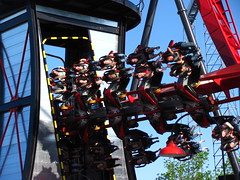 Just as it’s beginning to seem as if X-Flight would follow the same progression of diminishing action and anticlimax that plagues so many B&M designs, they throw a curveball and conclude with possibly the best part of the layout. The inline barrel roll makes maximum use of the Wing Coaster’s potential, combining the unusual dynamics of the non-heartlined configuration with the unique visuals of the open, exposed seating. I had heard reports that the visual near-misses on the other B&M wing coasters tend to go by unnoted, and while that was true of the 2D hangar, it’s not of the keyhole through the control tower. Granted, it didn’t exactly feel like a perilous near-miss (that we’ll rotate through the structure with plenty of clearance is never in any doubt, not even for a fleeting moment of instinctual response when it first comes
Just as it’s beginning to seem as if X-Flight would follow the same progression of diminishing action and anticlimax that plagues so many B&M designs, they throw a curveball and conclude with possibly the best part of the layout. The inline barrel roll makes maximum use of the Wing Coaster’s potential, combining the unusual dynamics of the non-heartlined configuration with the unique visuals of the open, exposed seating. I had heard reports that the visual near-misses on the other B&M wing coasters tend to go by unnoted, and while that was true of the 2D hangar, it’s not of the keyhole through the control tower. Granted, it didn’t exactly feel like a perilous near-miss (that we’ll rotate through the structure with plenty of clearance is never in any doubt, not even for a fleeting moment of instinctual response when it first comes into view) but it’s a cool visual effect nonetheless. It’s immediately followed by another special effect, a mist screen through the support columns as we’re turned completely upside down, and this technically can be considered a real collision, albeit a completely harmless one. (The mist was never on too strong that it became distracting, and I had no problems with it clouding up my glasses; yes, unsecured glasses are permitted on X-Flight, at least on the day of my visit.) The rotation speed of the twist is slow and stately,
into view) but it’s a cool visual effect nonetheless. It’s immediately followed by another special effect, a mist screen through the support columns as we’re turned completely upside down, and this technically can be considered a real collision, albeit a completely harmless one. (The mist was never on too strong that it became distracting, and I had no problems with it clouding up my glasses; yes, unsecured glasses are permitted on X-Flight, at least on the day of my visit.) The rotation speed of the twist is slow and stately,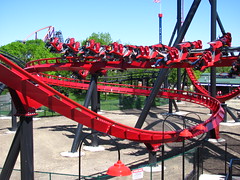 taking its time to hang us upside down before we’re once again righted. It’s an extended moment that lasts several beats longer than is normally expected from an inversion, which makes for a satisfying ‘grand finale’ to the entire experience. And that’s not counting the last helix, which is a nice denouement to release any remaining adrenaline before coming to a complete halt on the brakes; plus, tall folks on the far right side of the train might feel compelled to lift their feet up because they come very close to the ground.
taking its time to hang us upside down before we’re once again righted. It’s an extended moment that lasts several beats longer than is normally expected from an inversion, which makes for a satisfying ‘grand finale’ to the entire experience. And that’s not counting the last helix, which is a nice denouement to release any remaining adrenaline before coming to a complete halt on the brakes; plus, tall folks on the far right side of the train might feel compelled to lift their feet up because they come very close to the ground.
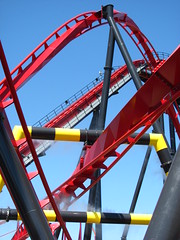 Comparing X-Flight to the similarly sequenced Swarm at Thorpe Park, I noticed where that ride seems to go wrong is that the barrel roll finale is too brief. You enter the brakes at the end thinking “is that all there is,” which is a very bad last impression to have if you want your ride to be considered a truly great attraction. (Of course, this is judging only from the POV videos and reading reviews that seem to corroborate this interpretation.) Even though they both have about the same rates of rotation, the Swarm starts the rollover already at 90° from the previous turn,
Comparing X-Flight to the similarly sequenced Swarm at Thorpe Park, I noticed where that ride seems to go wrong is that the barrel roll finale is too brief. You enter the brakes at the end thinking “is that all there is,” which is a very bad last impression to have if you want your ride to be considered a truly great attraction. (Of course, this is judging only from the POV videos and reading reviews that seem to corroborate this interpretation.) Even though they both have about the same rates of rotation, the Swarm starts the rollover already at 90° from the previous turn,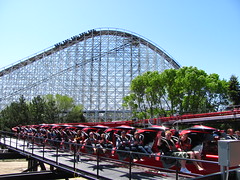 and ends as soon as it levels out into the brakes, meaning there’s only about 270° of rotation. X-Flight’s barrel roll, on the other hand, has two banked curves bordering either end that turn in the opposite direction of the roll, so the motion is unbroken for at least 450° of rotation. This stretches it out for several beats and makes
and ends as soon as it levels out into the brakes, meaning there’s only about 270° of rotation. X-Flight’s barrel roll, on the other hand, has two banked curves bordering either end that turn in the opposite direction of the roll, so the motion is unbroken for at least 450° of rotation. This stretches it out for several beats and makes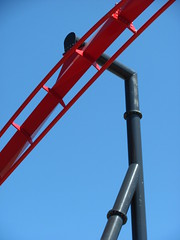 it feel like a completed action, whereas the Swarm still feels unresolved by the time you reach the brakes.
it feel like a completed action, whereas the Swarm still feels unresolved by the time you reach the brakes.
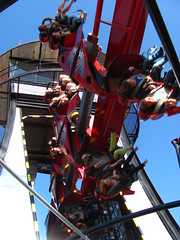 I know it’s not exactly considered good etiquette among coaster enthusiasts to compare rides you haven’t been on yet; apparently we’re all strict empiricists and can make absolutely no a priori claims about the world until we’ve encountered it first hand; this seems like bad news for the designers, whose best hope is to randomly plug together elements and hope the final result is okay. However, this feeling of completeness and resolution at the end of X-Flight seems to be missing from the other Wing Coasters, at least to the same degree,
I know it’s not exactly considered good etiquette among coaster enthusiasts to compare rides you haven’t been on yet; apparently we’re all strict empiricists and can make absolutely no a priori claims about the world until we’ve encountered it first hand; this seems like bad news for the designers, whose best hope is to randomly plug together elements and hope the final result is okay. However, this feeling of completeness and resolution at the end of X-Flight seems to be missing from the other Wing Coasters, at least to the same degree,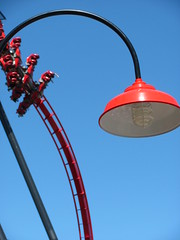 and I feel I can claim with a certain degree of confidence that X-Flight has the best layout of the four built so far. Of course, I reserve all claims about which of the four built so far is the best overall until I’ve actually ridden them, as there are too many other variables not present on X-Flight, most notably the stronger themeing on Swarm and Raptor, the additional height and speed on Swarm and Wild Eagle, or the natural forested setting of Wild Eagle.
and I feel I can claim with a certain degree of confidence that X-Flight has the best layout of the four built so far. Of course, I reserve all claims about which of the four built so far is the best overall until I’ve actually ridden them, as there are too many other variables not present on X-Flight, most notably the stronger themeing on Swarm and Raptor, the additional height and speed on Swarm and Wild Eagle, or the natural forested setting of Wild Eagle.
Regardless, X-Flight is certainly as good a roller coaster as I ever could have hoped for given the limited land and creative talent available at Six Flags Great America, not that my expectations were that high to begin with. I’m still waiting for the day when a new coaster will be announced that will do for the wing coaster what Tatsu did for the flying coaster, but judging on the relative successes of the design so far (especially compared to the still somewhat lackluster Air and Supermen models), if/when that day comes, the results should hopefully be one of Bolliger and Mabillard’s top career achievements.
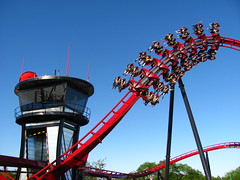
One final, semi-arbitrary note that didn’t fit in the main part of the review: the current set-up of the on-ride photo kiosk creates a huge bottleneck along the exit pathway. There’s a roughly six foot wide walkway between the booth and the fence. Not only are people who have no interest in their photo forced to wait for people who do have an interest to finish pointing and laughing at their reactions, but even people who are interested in their photo might not make it up to the screen display in time before they’ve cycled onto the next trainload. It’s a bit of a tight squeeze with track and supports on the opposite side of the fence, but widening this walkway by even three or four feet could make a world of difference. If there’s only one thing that could be changed on the ride that would be cheap and easy to do, it should be making some adjustment to this area.
The review left out that this ride is not very reliable. This ride broke down 6 times before I got to ride it on Saturday.
Hi Max; it sounds like we’ve had different experiences. They had some technical difficulties early in the morning before my first ride, but after those got sorted out we didn’t have any problems for the rest of the day (although we spent most of the afternoon checking out the rest of Six Flags). I’m not sure if six break downs in a short period is so far the exception or the norm, although that’s not entirely unexpected of any new attraction during the first couple weekends of park operation. Even if I had the frustrating experience it sounds like you were unlucky to be dealt, it’s not really fair to judge reliability until later in the summer when the crews have settled into their routines and the remaining kinks have been ironed out. I can’t think of any B&M coasters that continue to be regarded as generally unreliable for longer than their first couple months of operation, and I don’t see any immediate reason to believe X-Flight will break that trend.
My wife and I were also at the park to ride on Saturday, however we walked away with incredibly positive reactions. We rode twice, once at park open and the other mid-afternoon. We learned after we stepped out of the park for lunch that there was a power outage that rendered almost all of the major rides in the dark. (We were oblivious to that fact as we saw everything operating all day.) I was very pleased with it and believe it will be well received by the general public. Unfortunately that will only mean longer lines. Previously, the GP seemed to still be obsessed with Superman and, (more deserving)Raging Bull.
I believe you’re right that long lines can be expected for X-Flight in the medium-term. The queuing area set inside the layout footprint didn’t seem very long to me. They had a set of temporary switchbacks before the main entrance on the season pass holder date, mostly because the passholders would get backed up before the entrance because they needed to check everyone’s ID. I wonder if those are going to remain in use for the rest of the summer?
um, yeah im trying to wright a reasarch paper on this ride trying to compare it,but it seems from what ive read that this roller coaster is very un-reliable.im trying to compare this ride to the zipper ride,trying to say thats its better,but this is really not helping me with this reasearch paper,i think ima have to do this reasearch papers on something else.oh by the way i havent riden it.,so it makes this a little harder.:|.:):):):):):):):):).GOD Bless You All.:):):):):D:D:D.
http://www.flickr.com/photos/8311021@N03/4669812732/
Many will say I’m biased because SFGAm is my home park but this is one of if not the best addition SFGAm has added. I agree with nearly every addition the park has installed from Buccaneer Battle to Dark Knight or even our ropes course. Why? Because every attraction they have installed, I felt my park lacked & needed. Great America is very well rounded, it has so much to offer. With the addition of X-Flight, it was a thrill the park needed to bring back an old focus, the thrill seekers. Since 2004, the park has primarily focused on family attractions & how they could bring in those groups of customers. Since 2004, the park has added a new section(5 rides total, 1 coaster), a huge water park & tornado water slide the year after, A new childrens area, an indoor dark ride/coaster, a water ride, The Little Dipper from Kiddieland, a ropes course, & a huge water park expansion last year. People actually complain about these additions?! WHY?? Its all a different focus, & I’m glad they did it because with the addition of XF this year it made it all worth the wait. The ride is simple, yet incredible. It may not break records, be taller or faster than Raging bull, but it targets overall rider experience over any record that would soon be broken. I’m very proud of the park, I couldn’t have been happier with 2012’s new ride! I look forward to what the park has up their sleeves in years to come!
Although I’m not a water park person, I understand the appeal of them, and for what it’s worth it looks like Great America has built a pretty decent water park (or, at least, a quite large water park) in a fairly short amount of time. I do think we should be careful with assuming that just because we don’t appreciate the things a park adds, there are necessarily other people who do that justify the long period of no major five star attractions. Every time I’ve walked by the Buccaneer Battle has appeared fairly deserted (although I’ve only been in early or late season since it was built), and the Dark Knight without it’s preshow, queue themeing, or audio is now much the same way (only ten minute wait). However, the only thing I’ll really complain about is the relocation of the go-karts over by the Little Dipper; that area went from being one of the nicer, shadier areas in the park to an unbearable concrete hellhole that you can’t escape from the noxious fumes as you walk by.
Anyway, the roller coasters are the types of experience that Six Flags excel at and make most of their ticket sales through, so I think it’s reasonable to expect a bit more attention to those attractions. Over the last decade we’ve lost Shockwave, Deja Vu, and Iron Wolf, and gained Superman and X-Flight (not counting Dark Knight, which is more pointless now than it ever was, and Little Dipper, which isn’t a major experience and only a minor compensation for a much larger loss several miles south). I think they’re still a little behind where they should be at this point in history (especially as the only amusement park in the entire Chicago metropolitan area), but maybe that will change soon as they obviously can’t leave the Iron Wolf lot abandoned for too long. There’s also a tendency to overpraise new rides at parks with a respected legacy but haven’t added anything large scale for a long time. I’m hoping the praise for X-Flight (including obviously my own) is real and will stand the test of time as one of the few long-term signature attractions at Great America, but I guess we can’t know that for another couple of years.
I rode X-Flight on Sunday and got basically what I expected. It seems to be another addition to the horde of average coasters at Great America. It was a fun, enjoyable experience, but it did not at all blow me away (like Maverick did). Glad that the park finally got another major attraction though.
And you are very correct on the current Dark Knight status.